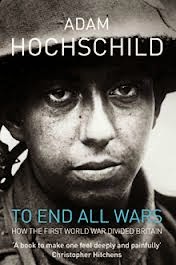Although many men signed up for the army in the early weeks of World War 1, as the reality of the war became clear at home, the number of volunteers rapidly fell. The war machine needed more men. In 1915 the Derby Scheme was introduced to register men for the armed forces and encourage recruitment. In early 1916 the Military Service Act became law introducing conscription for the first time in Britain. Under the terms of the Act men could apply for the status of conscientious objector. (CO).
To get this status they had to appear before a tribunal of local worthies. If exempted from military service as a CO there were a number of options – you could accept service in the Royal Army Medical Corps (under military discipline); you could agree to join a non-military organisation like the Friends’ Ambulance Service; you could accept transfer to ‘work of national importance’; or you could refuse to take any part in the war. Men who for moral, religious or political reasons took this last course were referred to as absolutists – they absolutely opposed the war.
Dozens of men from Bristol were imprisoned as absolutists from 1916 onwards. They were subjected to harsh conditions in prison and after the war many found it difficult to return to their jobs. They paid a great price for having the courage to stand up for their principles.
By following this link to the Bristol Radical History Group website you can read more and find a list of almost fifty men from Bristol who were imprisoned. There were certainly more. As the anniversary of the introduction of conscription approaches, we want to find out as much as possible about these men and their families. What led them to oppose the war? What happened when they appeared before the tribunals? What was their experience in prison? How were they treated after the war?
Please help us if you can. If you are interested in any of the men listed please get in touch and we can suggest ways you might find out more about them. If you know people interested in local history who might want to research any of them please send the link on to them. If you know of other men who were imprisoned please let us know.
For more information email rememberingrealww1@gmail.com
Author: jeremyclarke
The Gallipoli disaster 100 years on
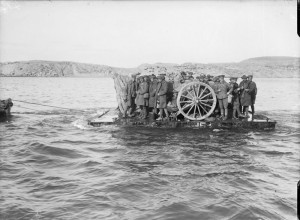
25th April is ANZAC Day which marks the start of the disastrous invasion of the Dardanelles, usually known as Gallipolli. In this centenary year it is being used here and in Australia and New Zealand to celebrate the re-writing of history and to promote new wars. As with all aspects of World War 1 it is important to remember what really happened.
You would think from most of the current stories in the media that it was a famous victory and that the participants were overwhelmingly Australian and New Zealand troops. Needless to say the real story is rather different.
This invasion of Turkey was caried out to further Britain’s war aims in the Middle East and to protect British interests in the area and further afield in India.
One of the main instigators of the disastrous plans was Winston Churchill. The whole scheme was based on racist assumptions about the inability and unwillingness of Turks to fight off any invasion.
From the first landings in April 1915 to the withdrawal of the invading armies in December 1915 and January 1916, the territory gained could be measured in hundreds of yards. The invading troops spent most of the months on or near the beaches on which they landed. In the case of the first Australian troops this was even the wrong beach!
At the end of the campaign over 86,000 Turks were dead, over 21,000 British troops, over 10,000 French troops, over 8,000 Australians and over 2000 New Zealanders, including many Maoris. Tens of thousands more were wounded on all sides. Soldiers of the Indian Army also fought there.
The survivors were all sent on the the Western front where many more of them died.
And of course the rulers of the Ottoman Empire were undertaking the massacre of the Armenians at the same time – 1.5 million people were killed.
A battalion of the Gloucestershire Regiment was sent to Gallipolli in July 1915. Over 300 of them were killed including many from Bristol. 180 of these men died on one day in August 1915. Bristol men serving in other regiments also fought and died there.
The myth is that Gallipolli forged the Australian nation. This a contested myth. Germaine Greer recently wrote this article in the New Statesman. This article by David Rowlands deals with the same myth, linking it to the genocide against the Armenians.
Some other useful resources to help in learning more about Gallipolli are:
- A short Australian film explaining some of the facts about Gallipolli – here.
- An episode of the 1960’s BBC series World At War – here
- A film made by Australian TV for the 90th anniversary, including interviews with veterans – here.
- An article about the Armenian genocide – here.
- More about the Armenian genocide – here.
Eric Bogle, wrote the classic song ‘The Band Played Walzing Matilda’ about the invasion. Hear it here sung by the Pogues, here by June Tabor and here by Eric Bogle himself. Read an interview with Eric Bogle here.
Black and Asian perspectives on WW1
A free event presented by M Shed on Saturday 14th February – 11.00am to 4.00pm
Over a million men from the Empire died alongside Europeans in the First World War, yet their stories are little known. Black and Asian perspectives on WW1 will explore this hidden loss through a day of pop talks and creative responses.
Join us for an informal day of pop up talks and creative responses to this hidden loss. There will be talks, film screenings and performance going on throughout the day.
Each will last from between 10 and 30 minutes – all exploring the non-white contribution to the First World War. Come along for as long as you like. Part of a programme of events to accompany the Moved by Conflict exhibition.
Full details here
Shot At Dawn
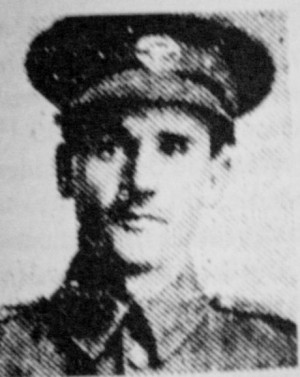
Arthur & Alfred Jeffries were two brothers from the St Philips area of Bristol. Both died in 1915 on the western front. Their deaths were both reported locally as ‘killed in action’. But Alfred had really been shot for desertion. Geoff Woolfe is researching their story. We plan to publish a pamphlet about Arthur & Alfred later in the year. In the meantime you can read more about their lives & deaths here.
Chloe Dewe Mathews is a photographer who has been commissioned to photograph the sites where deserters from the British Army. She spoke about this recently in Bristol. You can see information about the project and some of the moving photographs here.
For more information email rememberingrealww1@gmail.com
Testament Of Youth
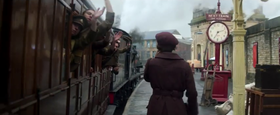
The new film of Vera Brittain‘s Wolrd War 1 memoir Testament Of Youth is released this week and is on at the Watershed in Bristol from January 16th.
The Watershed website says ‘A deft balance of romance and restrained sentimentalism with tough minded human tragedy, this is at once a manifesto of the female experience of war, a sobering account of the loss of a generation, and a brilliant ode to one of our greatest pacifist thinkers. This film is a chance for Brittain to deliver her message afresh, and what a rallying cry it is. ‘
More details including dates, times and details of post-film discussions can be found here.
For more information email rememberingrealww1@gmail.com
Videos Of Autumn Events
If you missed any of the events we presented last autumn, the videos of them are now available on line. They are listed below. Just click on the title to get through to the video
Wed 29th Oct 2014 World War One: Arming All Sides with the Arming All Sides project
Sun 2nd Nov 2014 Hidden Histories of World War One including:
The Christmas Truces 1914-15: Miracle, myth or mass mutiny? (Roger Ball, Bristol)
Compulsion, Conscription and Class: The case of the Forest of Dean Miners (Ian Wright, Bristol)
What are we fighting for? The East End and the First World War (David Rosenberg, London)
Opposition to WW1 in Germany: Rosa Luxemburg and others (Andrea Heubach, Berlin)
103 Foresters: Mutinies and death sentences in the local regiment 1914-18 (Philipp, Nottingham)
No Glory in War, Manchester – Alternative Ways of Marking the World War I Centenary (Ian Gwinn, Manchester)
Tue 4th Nov 2014 Women Resisting the Great War with June Hannam and Sheila Rowbotham
Thu 6th Nov 2014 Deserters, Conchies and Reds with Colin Thomas and Geoff Woolfe
Sat 8th Nov 2014 Trade Unions and Resistance to the Great War with Kevin Morgan and Ian Wright
Wed 12th Nov 2014 The World’s War with Dominic Rai
For more information email rememberingrealww1@gmail.com
Christmas Truce – Taste The Sentimentality
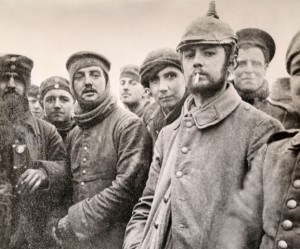
There are two common attitudes prevailing towards the 1914 Christmas truce – on the one hand it is sentimentalised as in the recent Sainsbury’s advert; on the other it is discounted as largely meaningless, if it even happened at all. Neither view takes any account of the wider context of the truce and assumes that it lasted a few hours (if at all).
The Sainsbury’s advert shows the truce as a brief interlude – not much mud in sight and remarkably well-scrubbed soldiers on both sides!
The advert has provoked a response from military historian Mark Connelly. This ‘expert’ claims that the truce was limited to ‘a couple of battalions’ and amounted to nothing more than a ‘day-off’ for a few soldiers.
A consensus seems to have developed that there is little or no documentary evidence of the truce. The Guardian recently reported the ‘discovery’ of a letter from a participant as if there were few other such letters. In fact, in 1984 a book called ‘Christmas Truce‘ by Malcolm Brown & Shirley Seaton was published. This drew extensively on interviews with participants, letters, diaries and regimental histories to give a full picture of events around Christmas 1914 – plenty of photos taken at the time as well. It even quotes the letter from Major-General Cotgrave that the Guardian reports as ‘never before seen’ until this month. This book was republished in 1994 and 2001. The authors made a film for the BBC in 1981 . The book is currently out of print but good second-hand copies can be bought online for less than £1 (plus postage). Well worth getting hold of.
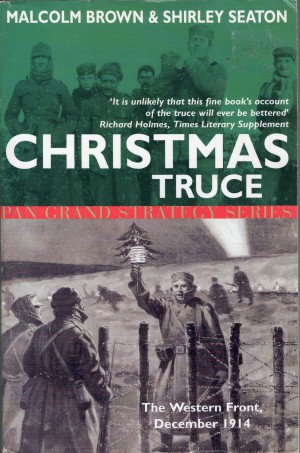
Brown & Seaton show that the truce, while not universal along the western front, did take place over at least two-thirds of the almost 30 mile stretch of the front occupied by British troops in Belgium and northern France. Letters and diaries tell us that troops from over 50 battalions of the British army fraternised with German troops along the front. Some of the German troops had spent time in England before the war and spoke English. It seems that among the extraordinary events of Christmas 1914, one British soldier got a haircut from his pre-war German barber!
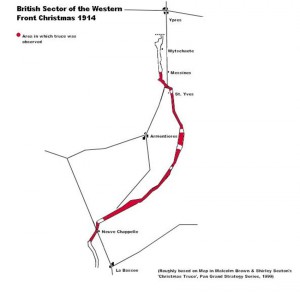
The truce began in most places on Christmas Eve and extended almost everywhere into Boxing Day, even though most soldiers had returned to their respective trenches. There was very little fighting before New Year. In many places there was very little fighting through January. Some places saw very little fighting through February. In at least one place the unofficial truce went on to the end of March – just before Easter 1915, when there were further attempts at fraternisation. Similar explicit events are also recorded in November 1915 and once again at Christmas that year.
Live and let Live
But the events of Christmas 1914 formed part of a wider pattern that began in the autumn of 1914 and went on well into 1915 and in some respects even longer. Throughout this time there were many unofficial truces and tacit agreements between troops on both sides to avoid killing each other. Books about the war allude to what came to be called ‘live and let live’. This is most thoroughly documented in a book called ‘Trench Warfare 1914-1918‘ by Tony Ashworth first published in 1980. It was re-published in 2000 in the same series as the Brown & Seaton book – bizarrely called ‘Pan Grand Strategy’. It draws on similar sources to that book. Like that book, it is also out of print but widely available cheaply secondhand online.
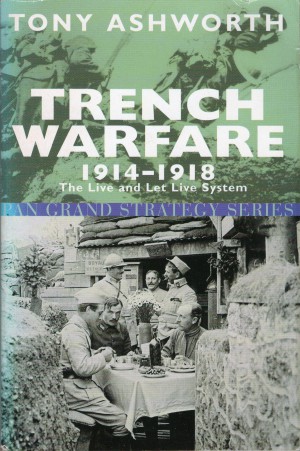
Ashworth explains that the common picture of the trenches as two implacably hostile front lines several hundred yards apart with an extensive area of no-mans land between them, is by no means the full story. Although this was the case in some places, it certainly wasn’t the norm. In many places the trenches were less than 100 yards apart, even as little as 50 yards apart. In some cases 10 yards. There is even one instance of the two trenches being in the same building. The proximity of the front-line troops facilitated direct and indirect forms of communication. Away from the main set-piece battles many sections of the front-line saw little or no fighting. In these areas, usually occupied by what Ashworth calls ‘non-elite’ troops, relationships built up between soldiers in the opposing trenches.
They came to understand that they had a mutual interest in keeping things as quiet as possible. If British troops could be confident that German troops would reciprocate then they would avoid killing them. This resulted in informal truces, suspensions of sniping, ritualised firing of weapons (e.g. firing weapons to look like combat was underway, whilst minimising opposition casualties) and routinised firing of weapons (e.g. always firing at the same time of day – breakfast time was often commonly avoided!). Ashworth describes how soldiers in the trenches were even able to get the help of artillery batteries in pursuing these tactics.
In these ‘egg and chips’ sectors (as the ‘Tommies’ named them), which Ashworth estimates were somewhere between a third and one half of the British-German frontline, the exchange of peace rather than the exchange of death became the norm. Of course such behaviours, which spread through the combatants on both sides, sometimes even influencing front-line officers, were certainly not officially sanctioned by the ‘brass’. In fact they were a complete anathema to military strategy on both sides which called for, outside of major offensives, a relentless war of attrition in the trenches. As Ashworth rightly points out, ‘Truces were usually tacit, but always unofficial and illicit’.
Faced with the widespread phenomenon of ‘live and let live’ military commanders adopted a number of strategies to build what they called ‘offensive spirit’ among their troops. Night patrols in no-mans land were introduced, although at times these were carried out in the least-threatening manner possible by both sides. Warfare was bureaucratised, with frontline officers having to make written reports to HQ every few hours on what they had achieved in the ‘war of attrition’, though these were often falsified or exaggerated. The ‘brass’ even produced a pamphlet for officers called ‘Am I offensive enough?’ which was explicit propaganda designed to combat ‘live and let live’ type behaviours. Needless to say it was widely ridiculed.
However, less easy to incorporate into ‘live and let live’ strategies were trench raids, small-scale, stealthy night attacks on opposing trenches. These vicious encounters, where assault groups were encouraged to use bayonets, hatchets and shovels as well as pistols and grenades to butcher their opponents in hand-to-hand fighting, were explicitly designed to spread fear amongst opposing troops and to break any tacit truces between the lines. Along with the horrors of the major offensives in 1916 and the use of gas, which intensified the brutalisation of the combatants, trench raids were a useful tool for the ‘brass’ on both sides in destroying cooperative behaviours between front-line troops.
Balls to War
So was there a football match on Christmas Day 1914? Almost certainly not in any formal sense, although there are sufficient first-hand reports of informal kickabouts that we can be sure they must have taken place. We have to remember that in many places no-mans land was pitted with shell holes – not ideal for playing football. Interestingly several first-hand accounts mention the idea of spending the days after Christmas Day levelling an area of no-mans land and holding a formal football game on New Years Day. This gives some idea of the scope which at least some soldiers envisaged for the truce. A good visual account of the events is given in Heathcoate Williams video, ‘Balls to War: a Sports Report from 1170 A.D. to the Present’.
So there was a truce at Christmas 1914 and there was extensive fraternisation between troops from both sides over large sections of the front for several days and in some cases for several months. Many of the participants record it in terms which suggest they saw it as one of the most significant events of their lives. It was not merely an aberration or a ‘miracle’ as it is often presented; in fact it formed part of a far-wider ‘live and let live’ response by troops on both sides to the situation they found themselves in during 1914 and 1915. Despite the efforts of the brass on both sides to stamp out these survival strategies, clandestine cooperation between front-line troops continued throughout the war in a number of different forms. Furthermore, the implicit refusal of ‘live and let live’ was echoed again in the more explicit mutinies, strikes and mass desertions that ensured the war became no longer tenable on the eastern front in 1917 and were a major contribution to the end of the war on the western front in 1918.
One thing we can be sure of is that it wasn’t much like the Sainsbury’s advert.
Bristol Local History Bookfair 2014
Remembering the Real World War 1 will have a stall at the Bristol Local History Bookfair on Saturday 6 December 2014 at Bristol Records Office. Lots of local history info plus interesting talks – one on Bristol At War 1914-1918
Date: Saturday 6th December 2014
Venue: Bristol Records Office, ‘B’ Bond Warehouse (via Create Centre), Smeaton Road, Bristol, BS1 6XN
Map & Directions: Here
Time: 10.00am to 5.00pm
Free entry.
10am-1pm
Family history advice from the Bristol & Avon Family History Society
1.30pm – Bristol: the City at War, 1914-1918 (Eugene Byrne, co-author of ‘Bravo Bristol!’)
As a major British city and port, Bristol played a key role in the First World War. Join Eugene for stories of Bristolians on the battlefield, on the Home Front and in the war at sea.
2.30pm – Unmarked Graves: the Eastville Workhouse Project (Dr Di Parkin, Bristol Radical History Group)
Between 1855 and 1895, over 3,000 paupers were buried in unmarked graves near Eastville Workhouse on Fishponds Road. Di Parkin will present a project to uncover the names of the people buried there.
3.30pm – Bristol’s Treasure Island Influences (Mark Steeds, Long John Silver Trust)
Hear from Mark about the pirates and privateers that inspired Robert Louis Stevenson to set parts of his classic book in the city.
See The Bristol Records Office website for full details
For more information email rememberingrealww1@gmail.com
Adam Hochschild Opens Our Autumn Events
Remembering The Real WW1‘s autumn programme of events opens with a rare opportunity to hear internationally renowned author & historian ADAM HOCHSCHILD speak, based on his book ‘To End All Wars – How World War 1 Divided Britain‘. If you haven’t already read Adam’s book (see here for an appreciation of it), copies will be available at the event. Also you can read Adam’s recent piece in the Guardian here.
1914-1918: The War within the War
Date: Thursday 23rd OctoberTime: 7.30pmVenue: MSHED, Princes Wharf, Wapping Rd, Bristol BS1 4RN Map: http://www.bristolmuseums.org.uk/m-shed/getting-here/ Price: £5 (£3 concessions)With: Adam Hochschild
As we mark the centenary of the First World War, this epochal event is usually remembered as a bloody conflict between rival alliances of nations. But there was another struggle as well: between people who regarded the war as a noble and necessary crusade, and a brave minority who felt it was tragic madness and who refused to fight. Writer Adam Hochschild describes this battle in an illustrated talk, focusing on the country where that tension was sharpest, Great Britain.
For more details see here
For full programme of events see here
For more information email rememberingrealww1@gmail.com
Autumn Events – Remembering The Real World War 1
Current details of the events being staged by Remembering The Real World War 1 in October and November are listed below. Three weeks of talks, films and art uncovering hidden histories of resistance to the ‘Great War’ in Bristol and beyond. From deserters, conchies and pacifists to rebel miners, radical trade unionists and reds. Featuring Adam Hochschild, Sheila Rowbotham, Gee Vaucher and Dominic Rai. Full details including times & venues can be found by following the links to our website. For more information email rememberingrealww1@gmail.com.
Thursday 23rd October – internationally renowned author & historian Adam Hochschild talks about ‘1914-1918: The War within the War’. Full details here
Wednesday 29th October – the Campaign Against the Arms Trade’s Arming All Sides project presents ‘World War One: Arming All Sides‘. Full details here
Thursday 30th October – explore Bristol’s cultural links to WW1 through the eyes of asylum seekers and refugees in ‘Echoes of the ‘Great War’: Imperialism, displacement and migration‘. Full details here.
Sunday 2nd November – delegates to the international History From Below Network conference will present ‘Hidden histories of World War One‘ from across the globe. Also Gee Vaucher of CRASS will be discussing her anti-war art which wil be on display.Full details here
Tuesday 4th November – hear Sheila Rowbotham talk about Alice Wheeldon who was framed and imprisoned for opposing the war and June Hannam talk about Bristol women who campaigned against the war in ‘Women Resisting the Great War‘. Full details here
Wednesday 5th November – come down to the Central Reference Library for ‘Opening the Archives: Resistance to World War One in Bristol‘. See primary sources relating to resistance and reaction during World War One. Full details here.
Thursday 6th November – hear the story of Alfred Jefferies, the Bristolian shot for desertion in November 1916, and how people in Bristol organised and campaigned against the war in ‘Deserters, Conchies and Reds: Bristolian Families in the Great War‘. Full details here
Saturday 8th November– historian Kevin Morgan discusses trades union opposition to the war and Ian Wright explains how divergent attitudes to the war effected the Forest of Dean Miners’ Association in ‘Trade Unions and Resistance to the Great War‘. Full details here.
Wednesday November 12th – following on from David Olusoga‘s recent documentary, writer-director Dominic Rai brings to life the experiences of Indian soldiers in Flanders, popularised in the acclaimed novel Across the Black Waters by Mulk Raj Anand in ‘The World’s War: Forgotten Soldiers of Empire‘. Full details here.
For more information email rememberingrealww1@gmail.com
